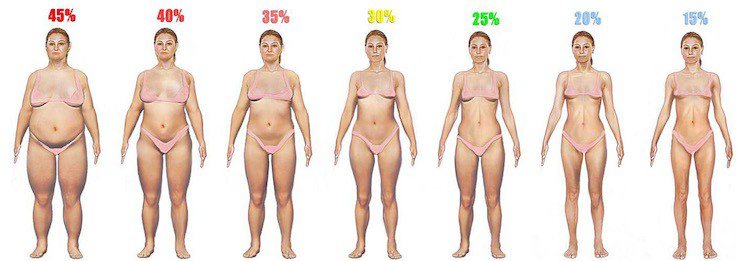Body Fat Calculator
A quick estimate using weight, age, and waist size.
Skinfold Method
Skin calipers will provide a far more accurate way of measuring body fat. Ensure that measurements are taken at exactly the same places each time.
Why Body Fat Percentage is Better than Weighing Yourself
Body fat percentage is a superior indicator of health and wellness compared to body weight (or BMI).
- It gives an indication of body composition (muscle and fat).
- Two people with the same body weight and height could have completely different body composition.
- A lower body fat percentage indicates a higher lean mass – and potentially better health and fitness outcomes.
Unfortunately some weight loss programs result in loss of muscle mass – you lose weight but maintain the same level of body fat (referred to as a "skinny fat" person).
Skinfold measurements are generally more accurate predictors of body fat than BMI. Waist circumference and waist-stature ratio can also help indicate body fatness. However these can be an inaccurate measure of estimating percentage body fat.
Body Fat Rating Scale
Based on categories defined by the American Council on Exercise.
| MEN | WOMEN | |
| Essential Fat | 2-5% | 10-13% ** |
| Athletes | 6-14% | 14-20% ** |
| 14-17% | 21-24% | |
| Acceptable | 18-24% | 25-31% |
| Obesity* | 25%+ | 32%+ |
*Men are considered borderline at 25% body fat and clinically obese at 30%, while women are borderline at 30% and clinically obese at 35% body fat.
**A lower body fat percentage for women increases chance of amenorrhea (cessation of menstruation).


How to Measure Accurately
It’s not easy, so follow these 4 steps to ensure the most accuracy.
- Use your regular measurements to see a pattern or trend rather than relying on exact measurements gained from fat calipers.
- When taking your measurements – do it 3 times to see the pattern.
- It’s important that you measure in exactly the same spot each time.
- Follow the instructions that come with the fat calipers carefully.
Other Methods: Body Fat Scales
Another way to measure body fat is to use a body fat analyzer.
These tools measure body fat using Bioelectric Impedance Analysis (BIA). A very low power current is passed through the body, and makes an assessment based on the level of water content in the body (muscle holds a high water content while fat holds a low content).
Analyzer tools cost more, but are easier to use compared with fat calipers.
If you are obese, you will find it easier to use a body fat analyzer.
As you become slimmer you may find calipers provide a more accurate result (as it is easier to "pinch" the fat).
Understanding Body Fat Distribution

Body fat is deposited in 3 places,
- under the skin (subcutaneous),
- around internal organs (internal fat), and
- fat inside muscle tissue (intramuscular fat).
Skinfold calipers measure the subcutaneous fat, and from this, derive a body fat percentage.
This explains why body fat analyzers are better for more obese people, as the amount if internal fat will normally be higher (and is not picked up by the fat calipers).
See more about fat distribution here.
Ideal Weight Loss
An ideal weight loss regimen would result in loss of fat while still maintaining (or even building) more muscle.
Muscle is metabolically active and burns calories just by sitting still! Not surprisingly this is very difficult to achieve.
Simply dropping food intake and doing nothing else will usually result in a loss of fat as well as muscle.
- Sarria, A., Garcia-Llop, L. A., Moreno, L. A., Fleta, J., Morellon, M. P., & Bueno, M. (1998). Skinfold thickness measurements are better predictors of body fat percentage than body mass index in male Spanish children and adolescents. European Journal of clinical nutrition, 52(8), 573-576. URL: http://europepmc.org/abstract/MED/9725657
- Gallagher, D., Heymsfield, S. B., Heo, M., Jebb, S. A., Murgatroyd, P. R., & Sakamoto, Y. (2000). Healthy percentage body fat ranges: an approach for developing guidelines based on body mass index. The American Journal of Clinical Nutrition, 72(3), 694-701. http://ajcn.nutrition.org/content/72/3/694.short
- Flegal, K. M., Shepherd, J. A., Looker, A. C., Graubard, B. I., Borrud, L. G., Ogden, C. L., … & Schenker, N. (2009). Comparisons of percentage body fat, body mass index, waist circumference, and waist-stature ratio in adults. The American journal of clinical nutrition, 89(2), 500-508. http://ajcn.nutrition.org/content/89/2/500.short